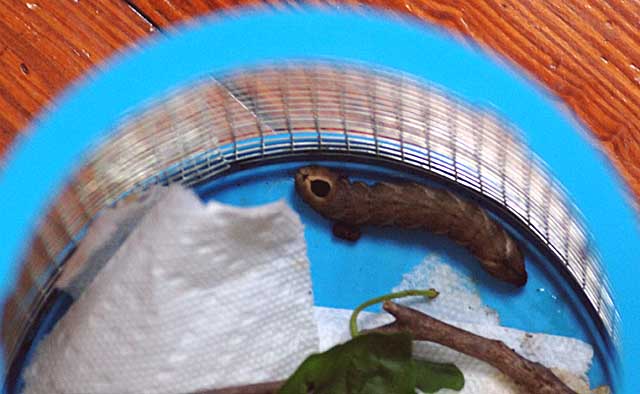
Lintneria eremitus fifth instar, Carroll County, Maryland,
August 5, 2010 courtesy of Kara.
|
|
Created/dedicated as per personal communication with Kara, August, 2010 Updated as per Butterflies and Moths of North America, formerly USGS, August, 2010 Updated as per James P. Tuttle's The Hawk Moths of North America, August, 2010 |

Lintneria eremitus fifth instar, Carroll County, Maryland,
August 5, 2010 courtesy of Kara.
For care of "found larvae/caterpillars" visit Manduca sexta larva, central Texas, August 21, 2008, Trina Woodall.
This page is inspired by and dedicated to
Kara, who provides the Lintneria eremitus image top of this page.
Kara writes, ``I am writing about the caterpillar that I have had in my possession for the past several weeks, which I finally was able to i.d. through
one of your pages.
``He was discovered accidentally on a cut bunch of basil that was in a water filled vase on my kitchen counter. He was exactly the same color as the leaf,
and really small (less than an inch long, and slender). I put him in a jar, with his own supply of basil, and continued to watch him change, which was
fascinating. I tried in vain to find him on the internet, with his two distinctive horns ... but no luck. He started to develop diagonal bands, pale at
first. When he slowed down his massive appetite one day, I was concerned for him (I have no experience raising these lovely creatures!), and monitored him
more closely. In the morning, he had morphed into a totally new worm! No longer the bright green, but a tawny brown color that seemed to change in texture
by the hour. The black spot that formed on his head was spectacular! No longer did he have a horn there, and the horn in the rear was yellow at first, with
a thin black line at the center. Eventually, it was all black. He grew to an enormous size, and eschewed any other type of leaf that I put in there. Basil
was on the menu in perpetuity.
``I am writing now because I just i.d.'d him from the aforementioned site yesterday, and he has taken a new turn.. interestingly... yesterday. He stopped
eating, and has been circling the open weave 'critter cage' that I moved him into a couple of weeks ago. I put several layers of torn paper toweling in the
bottom (as I saw suggested for pupating) and he moved around under those, but gave up on that idea and is looking smaller (did he shrink!?!?) and forlorn
on the plastic bottom of this container. His head looks a bit lighter in colour, other than the black spot. He definitely lost some mass and length since
yesterday. I wanted to rear him to the moth stage, but I certainly don't want him to expire on my watch! Can you give me some advice? I sure would
appreciate it! Thanks.
``p.s. I was going to take a picture of him, but he has now crawled underneath the paper toweling, between the plastic bottom and the first piece
of towel.``
I replied, ``Yes,
It is Lintneria eremitus. Shrinkage is typical just prior to pupation. It will probably settle shortly and pupate within three to five days.``
A "WO" after the species name indicates that I (William Oehlke) expect that this species is present or might be present. I have added quite a few species to the Maryland list.
A "USGS" indicates the moth is reported on the USGS website and/or in Lepidoptera of North America, #1. Distribution of Silkmoths (Saturniidae) and Hawkmoths (Sphingidae) of Eastern North America, an excellent little booklet available through Paul Opler.
Please help me develop this list with improved, documented accuracy by sending sightings (species, date, location), preferably with an electronic image, via email to Bill Oehlke.
 |
Ceratomia amyntor
WO,
the Elm Sphinx or Four-horned Sphinx |
 | Ceratomia catalpae WO, the Catalpa SphinxThis caterpillar is one of the few North American Sphingidae that feed in large groups. Colouration is distinctive. The larvae are much more spectacular than the moths. Catalpa is the larval host. |
 | Ceratomia undulosa WO, the Waved Sphinx
Note the pinkish-orange tail, spiracles outlined in red and the cream
stripes on the head. |
 | Dolba hyloeus WO, the Pawpaw Sphinx
Note the smooth skin, blue-black horn and small black spiracles. |
 | Lapara bombycoides WO, generally more westerly, the Northern Pine SphinxThis caterpillar is also without the anal horn and feeds on pines. The long stripes and reddish brown afford great camouflage. |
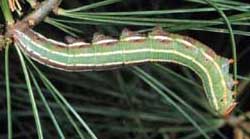 | Lapara coniferarum WO, the Southern Pine SphinxThis caterpillar is also without the anal horn and feeds on pines. The long stripes and reddish brown afford great camouflage. |
 | Lintneria eremitus Kara, the Hermit SphinxNote triangular bump on the thorax. Larval hosts are various species of beebalm (Monarda), mints (Mentha), bugleweed (Lycopis), and sage (Salvia). |
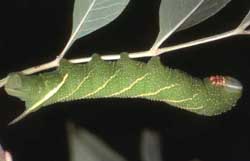 | Manduca jasminearum WO, the Ash SphinxLarvae feed on ash in the Fraxinus genus. Syringa and Ulmus have also been reported. Note the black anal horn. |
 |
Manduca quinquemaculatus
WO,
the Five-spotted Hawkmoth |
 | Manduca sexta WO, the Carolina SphinxNote the red horn and black dots anterior to the white oblique lines. If you grow tomatoes, you have probably encountered it. |
 | Paratrea plebeja WO, the Plebeian SphinxLarvae feed at night, hiding on the underside of stems during the day. Preferred hosts are common trumpetcreeper (Campsis radicans), Florida yellow-trumpet (Tecoma stans), lilac (Syringa species), and passionflower (Passiflora species). Questionable |
 | Sphinx chersis WO, the Northern Ash Sphinx or Great Ash SphinxNote pale blue horn and the creamy-white stripes on head. The yellow form has a red horn. Larval hosts are ash, lilac, privet, cherry and quaking aspen. |
 | Sphinx drupiferarum WO, the Wild Cherry SphinxLarvae hide in the day and feed primarily on cherry, plum, and apple at night. Larvae have been found on Amelanchier nantuckensis in Massachusetts and have been reared to pupation in Michigan on Prunus serotina. Note purple oblique lines. |
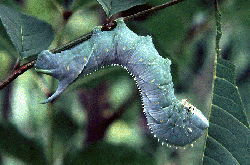 | Sphinx franckii WO, Franck's Sphinx MothLarvae feed exclusively on various species of ash (Fraxinus). Raised, pointed bumps, especially near the head and thorax give this caterpillar a reptilian appearance. |
 | Sphinx gordius WO, the Apple SphinxLarval hosts are apple (Malus), sweetfern (Myrica), Carolina rose (Rosa carolina), blueberry and huckleberry (Vaccinium), white spruce (Picea glauca), American larch (Larix laricina), and alder (Alnus). |
 | Sphinx kalmiae WO, the Laurel SphinxIn the final instar, the black on the head, lateral lines, horn and on abdominal legs is diagnostic. Larvae feed primarily on lilac and fringe. |
 | Amorpha juglandis WO, the Walnut SphinxAmorpha juglandis larvae feed upon Walnut and butternut (Juglans), hickory (Carya), alder (Alnus), beech (Fagus), hazelnut (Corylus), and hop-hornbeam (Ostrya). |
 |
Pachysphinx modesta
WO, generally more westerly; unlikely,
the Modest Sphinx or Poplar Sphinx |
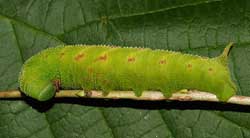 | Paonias astylus WO, the Huckleberry SphinxBlueberry and huckleberry (Vaccinium), cherries (Prunus) and willows (Salix) are the favorites as larval foodplants. |
 | Paonias excaecata WO, the Blinded SphinxLarvae accept willows, birches, and cherries. I have also found them in the wild on oak in eastern Canada. |
 | Paonias myops WO, the Small-eyed SphinxWild cherry species are the favorites as larval foodplants, but eggs will also be deposited on birches and other forest trees. There are varying degrees in the amount of red markings along the sides. |
 | Smerinthus jamaicensis WO, the Twin-spotted SphinxLarvae feed upon many forest trees including birches and cherries, but are expecially fond of poplars and willows. Red markings on sides vary greatly from specimen to specimen. |
 | Hemaris thysbe WO, the Hummingbird ClearwingThere is also an orangey-pink prepupal form. The lateral line runs from S1 to the blue horn. Hemaris thysbe larvae feed on viburnum and related plants. |
 |
Hemaris diffinis
WO, the
Snowberry Clearwing or Bumblebee Moth |
 |
Hemaris gracilis
WO, the
Slender Clearwing or Graceful Clearwing |
 | Eumorpha achemon WO, the Achemon SphinxLarvae feed upon Grape (Vitis), Virginia Creeper (Parthenocissus quinquefolia) and other vines and ivies (Ampelopsis). Larvae occur in both a light (green) form and a darker (tan/brown) form. Note six "segmented" oblique lines. |
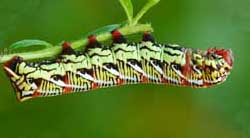 | Eumorpha fasciatus WO, unlikely, the Banded SphinxLarvae feed upon primrose-willow, Ludwigia (water primrose) and other plants in the evening primrose family (Onagraceae). Grape family members also serve as larval hosts. generally further south |
 | Eumorpha pandorus WO, the Pandorus SphinxIf you have Grape or Virginia Creeper nearby, then you might encounter this species. Note the five large white ovals. There are orangey-brown and green forms also. |
 | Amphion floridensis WO, the Nessus SphinixIn additon to Virginia creeper larvae accept Grape (Vitis), ampelopsis (Ampelopsis), and cayenne pepper (Capsicum). Larvae are green until the final instar. |
 | Darapsa choerilus WO, the Azalea SphinxLarvae feed on Azalea and Viburnum and progress very rapidly. The larva to the left on Viburnum cassinoides is getting ready to pupate. Color change from green to light burgundy-brown indicates pupation is imminent. |
 | Darapsa myron WO, the Virginia Creeper Sphinx or the Grapevine SphinxIf you have the foodplants indicated in the common names, you probably have this species nearby. The lower wings are orange. Larvae feed on Virginia creeper (Parthenocissus quinquefolia), Grape (Vitis), Ampelopsis, and Viburnum. |
 | Darapsa versicolor WO, the Hydrangea SphinxLarvae feed on Smooth hydrangea (Hydrangea arborescens), buttonbush (Cephalanthus occidentalis), and waterwillow (Decodon verticillatus). Note small head which can be retracted into the thorax. |
 | Deidamia inscriptum WO, the Lettered SphinxGrape (Vitis), ampelopsis (Ampelopsis), and Virginia creeper (Parthenocissus) all serve as larval hosts. The alternating yellow and greyish-green rings across the back distinguish this larva. |
 | Hyles lineata WO, the White-lined Sphinx
Larvae are highly varied and feed on a great diversity of plants
including willow weed (Epilobium), four o'clock (Mirabilis),
apple (Malus), evening primrose (Oenothera), elm
(Ulmus), grape (Vitis), tomato (Lycopersicon),
purslane (Portulaca), and Fuschia. |
 | Sphecodina abbottii WO, the Abbott's SphinxLarvae feed at night on grape (Vitis) and ampelopsis (Ampelopsis) and hide on the bark of their host plants during the day. Virginia creeper would also be a suitable host. There is also a dark form without the green patches. Note the "raised eye", replacing the anal horn. |
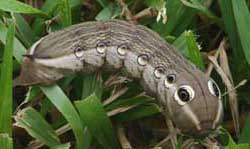 | Xylophanes tersa WO, the Tersa SphinxLarvae feed on Borreria, Catalpa and Manettia spp. and Smooth buttonplant (Spermacoce glabra) and starclusters (Pentas species). They are also recorded on joe-pie weed and Hamelia patens and on Hedoydis nigricans. The green form may be more common. generally more southerly and easterly |
This page is brought to you by Bill Oehlke and the WLSS. Pages are on space rented from Bizland. If you would like to become a "Patron of the Sphingidae Site", contact Bill.
Please send sightings/images to Bill. I will do my best to respond to requests for identification help.
Enjoy some of nature's wonderments: Saturniidae cocoons. Cocoons of the giant silkmoths may be purchased in the fall and winter. Big and beautiful giant silk moths will emerge in spring/summer. Read Actias luna rearing article. Additional online help available.
You can access checklists for other states, and even for other countries in the Americas via Sphingidae of the Americas.
This website has been created and is maintained by Bill Oehlke without government or institutional financial assistance. All expenses, ie., text reference support material, webspace rental from Bizland, computer repairs/replacements, backups systems, software for image adjustments (Adobe Photoshop; L-View), ftp software, anti-virus protection, scanner, etc. are my own.
I very much appreciate all the many images that have been sent to me, or of which I have been granted permission to copy and post from other websites. All images on this site remain the property of respective photographers.
If you would like to contribute to the maintenace of this website by sending a contribution to
Bill Oehlke
Box 476
155 Peardon Road
Montague, Prince Edward Island, C0A1R0
Canada
your donation would be much appreciated and would be used for
1) paying for webspace rental;
2) paying for computer maintenance and software upgrades;
3) purchases of additional text reference material (journals and books) in anticipation of expanding the site to a worldwide Sphingidae site;
4) helping to pay my daughter's tuition; with anything left over going to humanitarian aid.
If you are mailing a check from USA, please use $0.85 postage. Donations can also be made through Paypal via the button below.